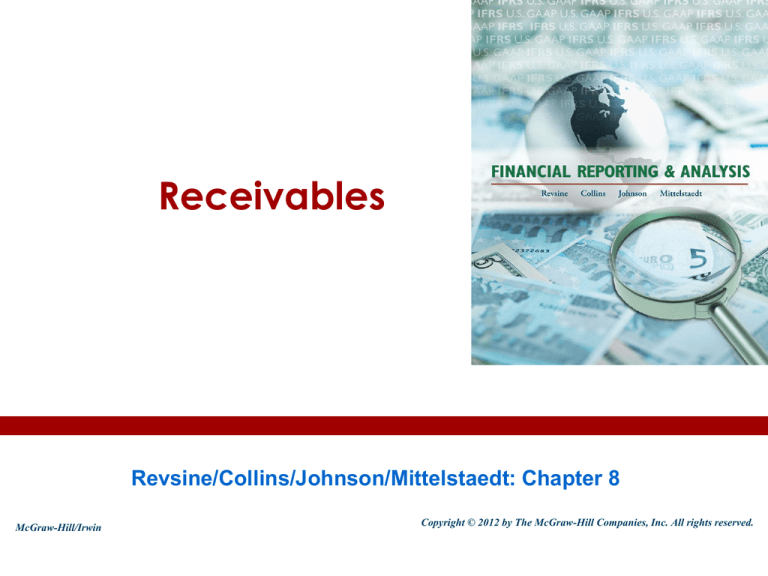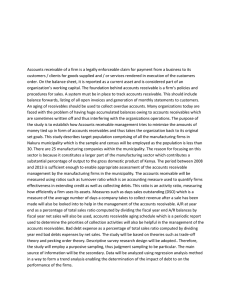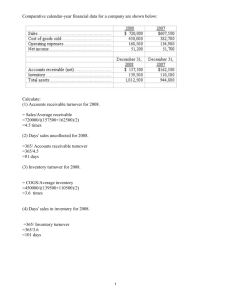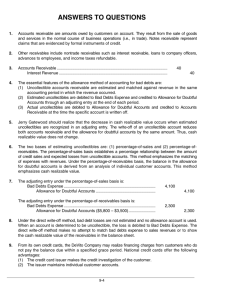
Receivables
Revsine/Collins/Johnson/Mittelstaedt: Chapter 8
McGraw-Hill/Irwin
Copyright © 2012 by The McGraw-Hill Companies, Inc. All rights reserved.
Learning objectives
1. How to account for accounts receivable using net realizable value.
2. How to analyze accounts receivable under net realizable value accounting.
3. How to spot whether or not reported receivables arose from real sales.
4. How and why interest is recorded on “non-interest bearing” notes.
5. How to account for accounts receivable and notes receivable using the fair
value option.
6. How companies use receivables to accelerate cash inflows and how this
affects financial statement ratios.
8-2
Learning objectives (cont.)
7. Why receivables are securitized and how this affects financial statement
ratios
8. Why receivables are restructured when a customer experiences financial
difficulty and how to account for the troubled-debt restructuring.
9. The key differences between current GAAP and IFRS requirements for
receivable accounting and possible changes.
8-3
Accounts receivable:
Assessing net realizable value
Accounts receivable are generally reflected in the balance sheet
at their net realizable value.
Two things must be estimated to determine the net realizable
value of receivables:
1. Uncollectibles—the amount that will not be collected because
customers are unable to pay.
2. Returns and allowances—the amount that will not be collected
because customers return the merchandise or are allowed a
reduction in the amount owed.
NRV of
receivables
=
Gross
amount
owned
-
Estimated
uncollectibles
-
Estimated
returns &
allowances
8-4
Accounts receivable:
Why estimating uncollectibles is important
Most companies establish credit policies by weighing the expected
cost of credit sales against the benefit of increased sales.
Customer collection and billing
costs plus potential bad debts
This tradeoff illustrates that bad debts are often unavoidable.
The matching principle requires that some estimate of uncollectible
accounts be offset against current period sales.
Today
Some future dates
Time
$10,000 current
period sales
$500 is
uncollectible
$500 estimated
expense
8-5
Accounts receivable:
Sales revenue approach
Bristol Corporation estimates that bad debt losses arising from first
quarter 2011 sales are expected to be $30,000.
DR Bad debt expense
$30,000
CR Allowance for uncollectibles
$30,000
A contra-asset account
subtracted from gross
accounts receivable
If Bristol’s gross accounts receivable and allowance for uncollectibles
before recording this bad debt entry were $1,500,000 and $15,000, then
after the entry the balance sheet would show:
8-6
Accounts receivable:
Sales Revenue approach
8-7
Accounts receivable:
Gross receivable approach
Management believes that
3% of existing gross
receivables will ultimately be
uncollectible
Notice this
second step
8-8
Accounts receivable:
Do existing receivables represent real sales?
Reasons why receivables might
grow faster than sales:
•
Change in credit policy.
•
Deteriorating credit worthiness
among existing customers.
•
Firm has changed its financial
reporting policy – accelerated
revenue recognition.
Sales
Receivables
Time
8-9
The Fair Value Option
Bristol Corporation
Recall that Bristol Corporation reports a net realizable value of
$1,455,000 (gross receivables of $1,500,000 minus allowance for
uncollectibles of $45,000).
Assume that there is an active market for these types of
receivables and that the price is 95% of face value, or $1,425,000.
To adjust the receivable’s carrying value to fair value, the
difference between the fair value and the face amount of the
receivable is recognized as an unrealized loss on the income
statement as follows:
An asset valuation account that is adjusted
upward or downward as fair values change
8-10
Accelerating cash collections:
Sale and collateralized borrowing
There are two ways to accelerate cash collections:
Companies might want to accelerate cash collection: (1) to avoid
processing and collection costs; (2) because of a cash flow imbalance
between supplier payments and receivable collections; or (3) to fund an
immediate cash need.
8-11
Accelerating cash collections:
Is it a sale or a borrowing?
Sale of receivables:
The FASB has provided guidelines in
the Accounting Standards Codification
Receivables removed
from balance sheet
Gain or loss
recognized in income
Is control
surrendered?
Yes
Borrowing against
receivables
Receivables stay on
balance sheet
Loan shown as
balance sheet liability.
No gain or loss
recognized in income
Sale
No
Assets are beyond
reach
Buyer has right to
dispose
Seller has no obligation
to repurchase
Borrowing
However, ambiguities abound.
8-12
Accelerating cash collections:
A closer look at securitizations
Bank
Receivables
transferred
in exchange
for cash
Mortgage
receivables
Customer
Bank forms a bundled portfolio of
7% home mortgage receivables
of “moderate” risk.
Investor
A third-party investor is willing to
buy the portfolio at a price that
yields a 6% return.
Because the selling price at 6%
is higher than the carrying value
of the mortgages, the bank
records a gain.
Both the bank and the investor
win in this transaction.
8-13
Troubled debt restructuring
When a customer is financially unable to make required interest
and principal payments, the lender can force the customer into
bankruptcy or restructure the loan receivable.
The restructured loan can differ from the original loan in several
ways:
Scheduled interest and principal payments may be reduced or
eliminated.
The repayment schedule may be extended over a longer time period.
The customer and lender can settle the loan for cash, other assets,
or equity interests.
Restructured loans benefit both the customer and the lender.
8-14
Troubled debt restructuring:
Summary
8-15
Global Vantage Point
Comparison of IFRS and GAAP Receivable
Accounting
IFRS is similar to the accounting under U.S. GAAP – called
amortised cost which refers to the gross amount of the receivable
and an allowance for doubtful accounts is created.
IFRS allows a more limited version of the fair value option
IFRS – firms may elect the fair value option only in cases where it
eliminates an accounting mismatch or because a group of assets are
managed and evaluated using fair values.
GAAP
IFRS
Allows the fair
value option
for a broader
set of
transactions
Requires fair value
disclosures for shortterm trade receivables
and loans in addition to
long term notes
receivable
8-16
Summary
GAAP requires that accounts receivable be shown at their net
realizable value.
Two methods are used to estimate uncollectibles: (1) the sales
revenue approach, and (2) the gross accounts receivables
approach. In either case, firms still must perform an “aging”.
Analysts should scrutinize the allowance for uncollectibles
account balance over time.
Receivable growth can exceed sales growth for several reasons,
including when aggressive revenue recognition practices are
being used.
8-17
Summary continued
It is sometimes necessary to “impute” the effective interest rate on
a note receivable.
Firms may elect the fair value option for accounts and notes
payable. Changes in fair value are recognized in net income.
To accelerate cash collections, firms sometimes transfer or
dispose of their receivables. These transactions take the form of
factoring (a sale) or collateralized borrowing (a loan).
ASC Topic 860 Transfers and Servicing of the FASB Accounting
Standards Codification provides guidance for distinguishing
between the sale (control is surrendered) and borrowing (control
is not surrendered).
8-18
Summary concluded
Subprime loans and securitizations were at the heart of the 2008 economic
crisis. Accounting and regulatory reforms are underway to address some of
the problems identified during the crisis.
Lenders often restructure loans when the customer is unable to make required
payments. These troubled debt restructurings involve (a) settlement, or (b)
continuation with modification of debt terms.
When terms are modified, the precise accounting treatment depends on
whether the sum of future cash flows from the restructured note are above or
below the original note’s carrying value at the restructuring date. Remember,
the interest rate used in accounting for troubled debt restructurings may not
reflect the real economic loss suffered by the lender.
Both the FASB and the IASB have projects on financial instruments and
derecognition.
8-19





